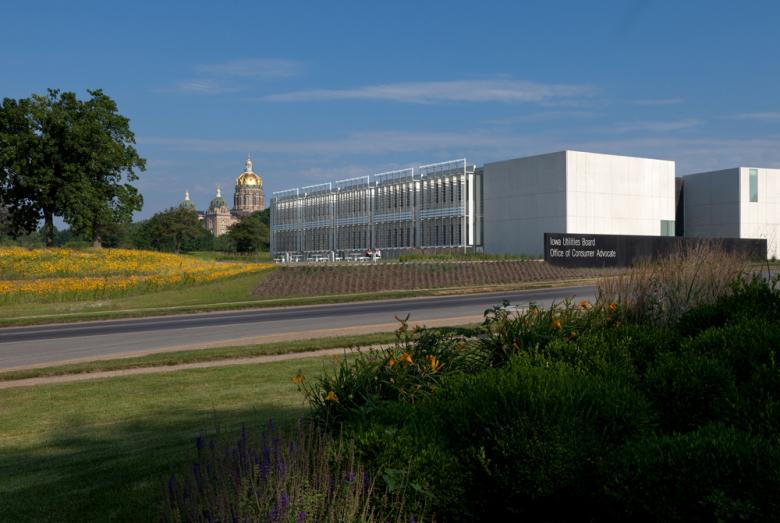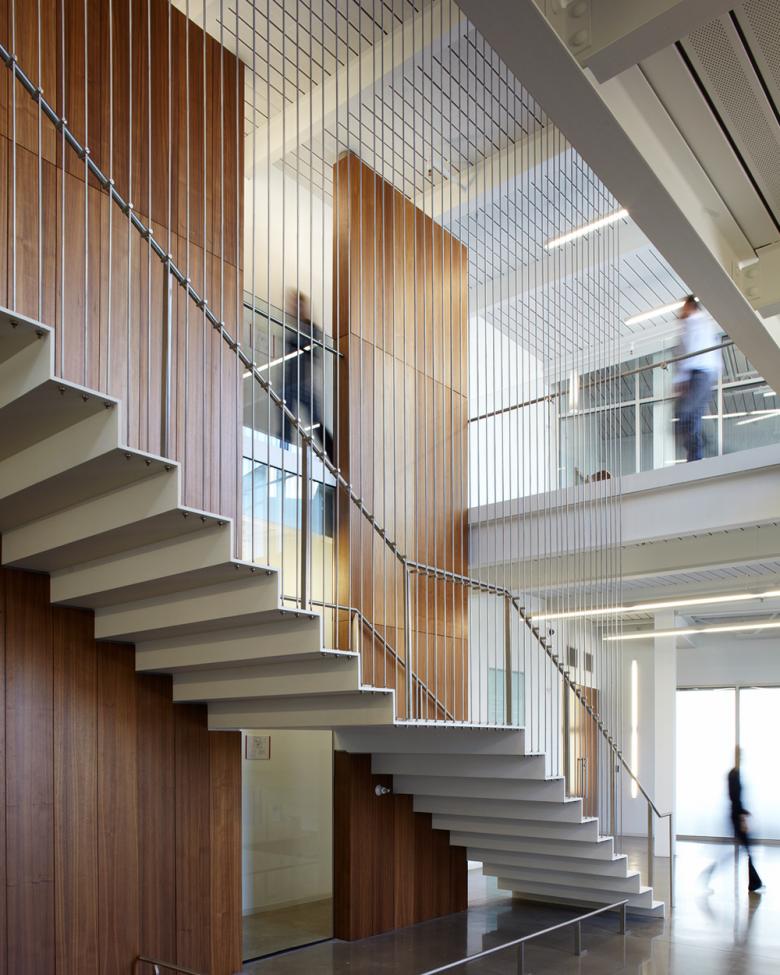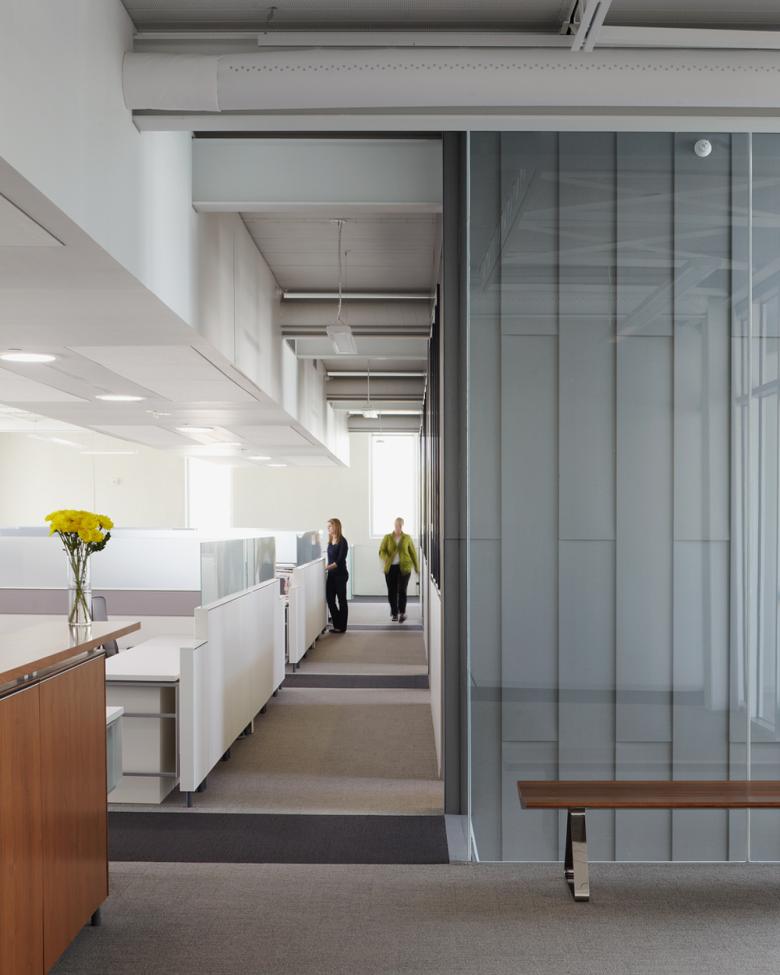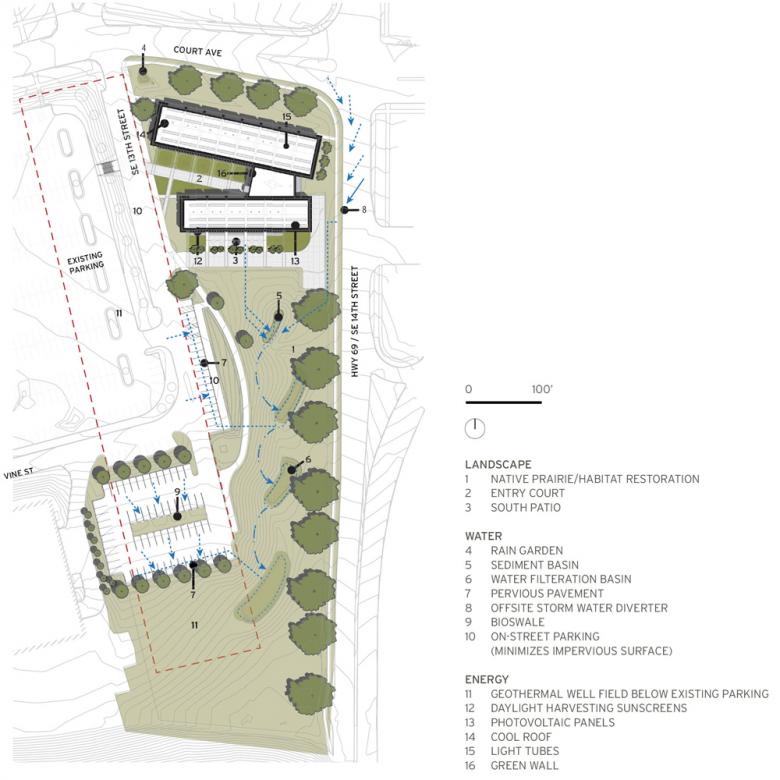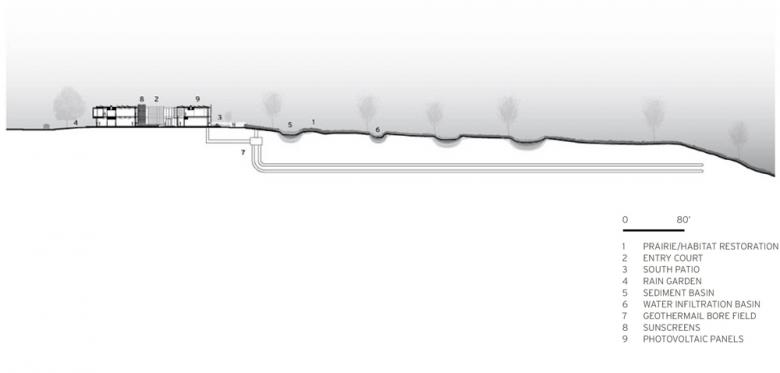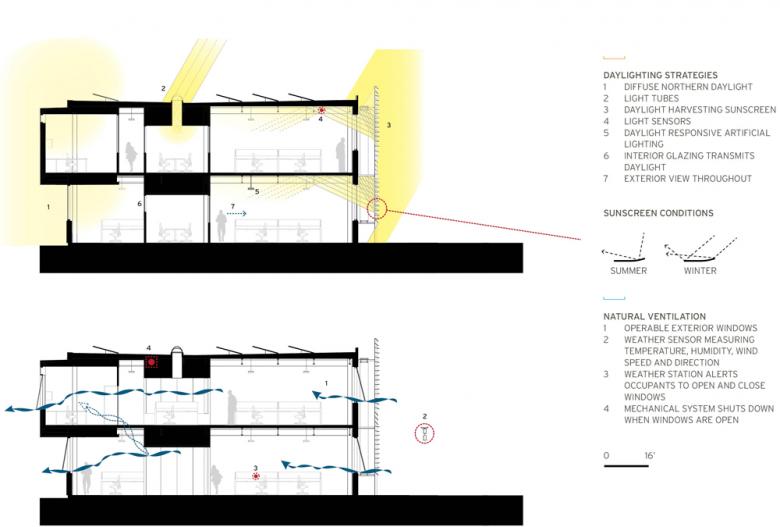Iowa Utilities Board – Office of Consumer Advocate
Iowa Utilities Board – Office of Consumer Advocate
15. April 2013
BNIM's ability to craft sustainable architecture has been explored here previously in the Omega Center for Sustainable Living, one of the few buildings to achieve "Living" status from the Living Building Challenge. In the heart of America's Midwest they have extended their belief in "designing places that are healthy, economically responsible and are regenerative stewards of all natural systems" with the Iowa Utilities Board - Office of Consumer Advocate. The architects answered some questions about the crisply detailed, light-filled building.
Building exterior
Can you describe your design process for the building?
The team utilized a process to create net-zero-ready architecture. With increased attention on the cost and availability of our finite natural resources, buildings designed with the potential to incrementally add functionality to produce as much energy as they use are an increasingly appealing decisions for businesses and governments protecting their fiscal resources.
The owner’s clear vision for stewardship, inspired by the State‘s commitment to a high performance building, empowered the team to focus on performance strategies with full owner support from the project’s inception.
To achieve such results, BNIM and a collaborative team including the owner and specialized consultants, utilized an integrated design process.
The team prioritized a primary goal to initially employ passive strategies to achieve the energy and performance goals of the facility supported by appropriate building systems. Secondly, the team established a LEED Platinum rating as a secondary goal, giving elevated importance to a range of sustainable strategies such as stormwater management, water conservation and responsible material use.
The Open Office environment is bright, filled with light and open to views of the outdoors
The design firm worked closely with the Iowa Energy Center (IEC), a part of Iowa State University, but funded through the utilities board. The design team, IEC and the owner worked collaboratively to discover the next level of high performance design strategies for the new building. The IEC studied and modeled components and, with these results, the team could discuss the effectiveness, as well as the owner’s goals. This transparent and open feedback loop allowed strategies to be evaluated quickly and collaboratively for the best decisions and results in the project. The IEC currently conducts the measurement and verification of the building’s actual energy performance while actively using it as the basis for ongoing research and as a case-study in replicable process and strategies for wide reaching implementation, furthering its demonstration components.
Passive strategies capture the “free energy” first — the energy that was only being used to counterbalance decisions that work against the site, climate and orientation. Only after load reductions through passive means are efficiently implemented can renewables be considered. This is the greatest opportunity for market rate, net-zero projects to be come a realistic norm. With such design decisions, many can be positioned to take advantage of forthcoming cost-effective renewable strategies, which allow the projects to achieve a net-zero goal in the future.
Using an integrated design process inclusive of external collaborations and post-occupancy evaluations for measuring results, the building has achieved its ultimate goal. The project is outperforming its original goal at 69% energy savings prior to consideration of on-site renewable energy production.
Lobby stair
How does the completed building compare to the project as designed? Were there any dramatic changes between the two and/or lessons learned during construction?
Due to a rigorous design process, which vetted many decisions thoroughly and included modeling to determine performance, the project was constructed as designed.
The documentation process exposed the need for construction innovations, which were tested and revealed through detailing and ultimately construction. These serve as lessons to future projects designing for progressive energy performance.
Material Duality: The project adopted a philosophy of material duality. Finish choices reduced material use and were selected for their inherent qualities, to integrate with the sleek design, contribute to a healthy environment, and represent the State’s efficient use of limited resources. The team exploited structural elements as finished materials, choosing to tightly detail these to create an elegant aesthetic. The interior finish of the precast panels is exposed as a lightly sandblasted hard-troweled concrete finish, which saved significant material, cost and greatly reduced drywall dust, which led to a healthier construction site. Over 50% of the ceiling is exposed acoustical composite deck; the lobby and restrooms make use of a finished concrete deck. The reduction in materials also freed finances for achieving energy goals, such as the geothermal bore field.
Office hall
Thermal Bridging: The envelope was obsessively detailed to avoid thermal bridging, which is typically responsible for significant envelope losses in traditional construction. In this climate of hot/cold extremes, white Thermomass precast concrete (with continuous insulation and non-thermally conductive ties) provides a simple yet high performance envelope, eliminating traditional thermal bridging at roof interfaces, foundation walls and wall openings. The team innovated details that allow insulation to wrap uninterrupted from the roof into the thermal wythe of the wall panel and then down and around the foundation system and across the underside of the slab on grade. These detail innovations are now being delivered as “standard options” in the manufacturer’s offerings.
Daylighting: Ultimately, over 95% of regularly occupied spaces have daylight and views due to the vast glazing at the northern and southern elevations. The team innovated the design of a daylight harvesting sunscreen that was modeled to exceed the performance of traditional louvers by capturing daylight down to eye level rather than the 8’ height offered by traditional light shelf systems. Louvered sunscreens, with horizontal blades and vertical fabric panels at the south elevation of each wing, reflect daylight deeply during all seasons, block unwanted summertime heat gain and allow passive winter heating. The parabolic profile reflects high elevation summer sun off of the curved portion and low winter sun angles off of the flat portion of the louvers.
Site Plan
How does the building compare to other projects in your office, be it the same or other building types?
The project is not unlike many other projects within the firm. BNIM strives to do more with less. This project is a market-rate net zero energy building. The primary difference between this project and your average office building is the rigor of the design process. Through the process of first employing passive design strategies, IUB was designed for hyper-efficiency, to reduce loads to the point where on-site renewable energy is appropriate and feasible, making the building “Net-zero ready.” Roof mounted photovoltaic panels currently account for 19% of the building’s energy usage reducing its net purchased energy to 17.4 kBTU’s, a 75% reduction below the code baseline.
Many clients come to the firm with goals, but the goals of this client — to achieve an energy use intensity of 28.0 kBTU/SF per year, equivalent to 60% energy savings beyond the energy code baseline (ASHRAE 90.1-2004) — were pointed and specific.
These specifics allowed the team to focus on a design approach that would first address appropriate massing and envelope strategies and then employment of efficient systems. As a result, loads were reduced to the point that on-site renewable energy was appropriate; knowing more could be added later.
Similar strategies are often used in the firm’s other projects and clients often select the firm based on past performance in design excellence and deep sustainability. The firm believes the only choice is designing places that are healthy, economically responsible and are regenerative stewards of all natural systems. Every design is unique in terms of its site, context, functional requirements, technological potential and role in its community and culture. However, a commonality in all projects is a design process that is collaborative, integrated and participatory, where all voices can be heard, from specialist engineers, designers and constructors to clients and users.
Site Section
How does the building relate to contemporary architectural trends, be it sustainability, technology, etc.?
The Iowa Utilities Board – Office of Consumer Advocate Office Building addresses contemporary trends in its design.
Long Life, Loose Fit: The building’s parti, with two wings emanating from a central lobby, supports long-term flexibility. Each wing utilizes an open plan configuration, and the modularity of the workplace design allows the space to adapt to changes or relocation of staff. The wings were chosen to support a seamless future addition to the south should the need arise. A flexible approach extends to the support spaces, where conference areas were sized and designed to serve the entire capitol complex. Large conference rooms share an operable partition to scale them up or down. Durable materials such as zinc cladding and precast concrete wall panels were used to allow for a 100-year useable life, no matter the tenant.
Monitoring System: The building has a significant amount of metering; nearly every outlet can be monitored. Real-time data is monitored and analyzed to improve building performance. This work is being done in partnership with the State of Iowa Department of Administration and the Iowa Energy Center.
To conduct this monitoring, all outlets are designated as critical power, non-critical power or task lighting. Open office and enclosed offices outlets are tied to occupancy sensors that shut down all non-critical loads when not in use (everything except CPUs). Task lighting circuits are individually monitored as part of a larger daylighting study effort within the building to understand the extent of savings and total energy use assigned to artificial lighting.
The Energy Center will further use results to support various research projects. This partnership further magnifies the project demonstration goals and ensures others will learn from this example.
Building Section
How would you describe the architecture of Iowa and how does the building relate to it?
This project is located within the State of Iowa Capitol Complex — it is, quite literally, architecture for the State of Iowa — and is an infill development on the 6-acre site of a former landfill. As a gateway to the complex at its Southeast corner, the project is a figural and literal threshold to the powerful example of government — supported by location and by its demonstration of replicable strategies for performance and savings. Though aesthetically different from the existing historic stock of the government district, it’s respectful in terms of scale and proportion.
This project is comparable to most architecture in the State of Iowa, in that it responds to the needs of its client within relatively modest means. It is a simple building. However, this project is different from most, in that it proves that the challenge of elegant design and exemplary performance can be solved even within limited budgets.
It had a triple mission to demonstrate efficiency, educate the public and save resources, and to do so while enhancing occupant comfort creates an inspiring, healthy work environment that facilitates collaboration. The building is a symbol of the efficient use of the state’s limited resources, an outward expression of environmental responsibility.
Exploded Axonometric
The building sits at the northern edge of the site. The landscape here transitions to a more formal expression in order to merge this site with that of the larger Capitol Complex. The entrance courtyard is comprised mostly of beds filled with little bluestem, a dominant species in the pre-development history of the state. These more organized plantings blend the building into the landscape while showcasing a symbol of the state’s natural history.
The site’s native prairie restoration provides wildlife habitats for native species. Tall-grass prairie once covered the majority of the state, but within 15 years of the Civil War, it was virtually wiped out. The native prairie restoration occurring on-site, a symbol of the pre-settlement state of Iowa, has multiple benefits in that it comprises significant components of the stormwater treatment train, slows the rate of stormwater flow and establishes a wildlife habitat; the native landscape eliminates the need for site irrigation.
Email interview conducted by John Hill.
Email interview conducted by John Hill.
Iowa Utilities Board – Office of Consumer Advocate
2011
Des Moines, Iowa
Client
State of Iowa
Architect
BNIM
Kansas City, MO
Design Principal
Rod Kruse, FAIA
Project Architect
Carey Nagle, AIA
Structural Engineer
Charles Saul Engineering
MEP/FP Engineer
KJWW Engineers
Landscape Architect
BNIM
Lighting Designer
BNIM
Interior Designer
BNIM
Contractor
J.P. Cullen
Building Area
44,640 sf
Drawings
BNIM
Kansas City, MO
Design Principal
Rod Kruse, FAIA
Project Architect
Carey Nagle, AIA
Structural Engineer
Charles Saul Engineering
MEP/FP Engineer
KJWW Engineers
Landscape Architect
BNIM
Lighting Designer
BNIM
Interior Designer
BNIM
Contractor
J.P. Cullen
Building Area
44,640 sf
Drawings
BNIM
Related articles
-
Spotlight on Italy
on 5/16/18
-
Bologna Shoah Memorial
on 7/20/15
